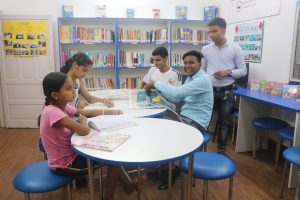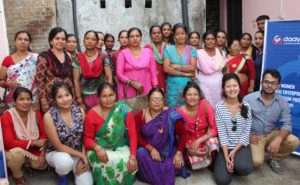Foster programming
Foster programming
The international learning group is formed. Together they have determined goals, milestones, and developed a tailor-made learning programme to share, test and blend the chosen solutions in the local context.
Visiting 2 initiatives in Nepal
READ Center Nepal
"Literacy is often the first step, opening doors to trainings in livelihoods and technology"
 What can we learn from READ Center Nepal?
What can we learn from READ Center Nepal?
READ has its roots in Nepal, where their first office opened in 1991 after a rural villager told the founder that all he wanted for his village was a library. Since then they have opened READ Centers across the country, offering training programs in livelihood skills, literacy, health, and technology. With their partner communities, they have seeded sustaining enterprises that address community needs: from fish farming and turmeric farming to a community radio station. Almost 4,000 women participate in savings cooperatives at READ Centers in Nepal.
What are we going to do?
- Visit the main READ office in Kathmandu
- Learning the methodology
- Visiting the Jhuwani Community Library and Resource Center
- Meeting the management committee of the Library
- Stakeholders meeting
- A walk through the village. Meeting women entrepreneurs at their homes
- Visit the Agyauli Community Library and Resource Center
- Stakeholders meeting
Itinerary Daayitwa - Women Rural Enterprise Accelerator Program
"Identifying women entrepreneurs as role models via a community-based approach for a thriving Nepal"
 What can we learn from Initerary Daayitwa?
What can we learn from Initerary Daayitwa?
The Women Rural Enterprise Accelerator Program uses a community-based approach to encourage women's entrepreneurship. They select top entrepreneurs based on a jury and public votes. These women receive leadership training, and are funded for their enterprises. Additionally, the program raises awareness bout and promotes women-led enterprises in rural communities.
The WREAP model fosters multi-stakeholders engagement from the private sector, local government, and community leaders and local community members. Their model combines in a smart way key stakeholders to collaborate in identifying, empowering and accelerating the innovations of women entrepreneurs. In this way it aims to create a ripple-effect that addresses opportunities for women entrepreneurs and can help them to overcome key barriers.
What are we going to do?
- Learning the WREAP model
- Entrepreneur site visit in Tansen
- Meeting with the WREAP entrepreneurs
- Entrepreneur site visit in Harthok
- Meeting with the WREAP entrepreneurs
- Entrepreneur site visit in Barangdi
